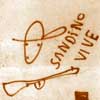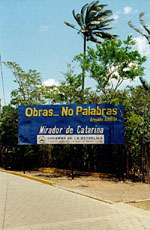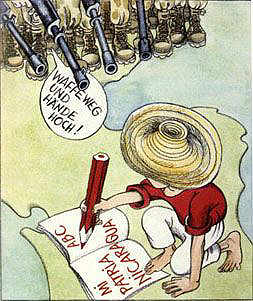nicaragua
Good vs Power
From Orion Magazine:
“Would any sane person think dumpster diving would have stopped Hitler, or that composting would have ended slavery or brought about the eight-hour workday, or that chopping wood and carrying water would have gotten people out of Tsarist prisons, or that dancing naked around a fire would have helped put in place the Voting Rights Act of 1957 or the Civil Rights Act of 1964? Then why now, with all the world at stake, do so many people retreat into these entirely personal ‘solutions’?”
Via Design Action and Design Activism I found this essay by Derrick Jensen on the polite activism of personal consumption and “living ethically.” Though Jensen doesn’t direct it at designers specifically, he identifies a strong trend in contemporary activism that’s pervasive amongst designers, particularly in the whole sustainable design movement. I’ve noted this before, as have others: after a hard strategic review last year, the World Wildlife Fund published a major report attacking green consumerism and “behaviour-change” strategies, calling instead for radically different approach to environmentalism.
 Sometimes constructing alternatives can be an effective way to go, the Free Software movement being one shining example. But at the risk of spoiling his punch line, Jensen points to successful political struggles of the past: “We can follow the example of those who remembered that the role of an activist is not to navigate systems of oppressive power with as much integrity as possible, but rather to confront and take down those systems.”
Sometimes constructing alternatives can be an effective way to go, the Free Software movement being one shining example. But at the risk of spoiling his punch line, Jensen points to successful political struggles of the past: “We can follow the example of those who remembered that the role of an activist is not to navigate systems of oppressive power with as much integrity as possible, but rather to confront and take down those systems.”
Which is a good segue to this excellent roundup of real-world graphic agitation by Josh MacPhee, Street Art and Social Movements in Paris in May 1968, Nicaragua in the late 1970s, South Africa in the early 1980s, and finally Argentina from 2001-04.
Logo Repo
El Nuevo Diario reports that 1,420 Nicaraguan banana workers have died as a result of the illnesses caused by the pesticide Nemagon. 9,500 are seriously ill without access to adequate healthcare.
In their battle to collect on their compensation claim, the workers have seized an unexpected asset.
From the Nicaragua Network, 1/18/06:
Nemagon victims put lien on use of “Shell” trademark
“On January 13 the law firm Ojeda, Gutierrez, and Espinoza put a lien on the multinational Shell Oil Company against which the firm’s clients won a multimillion compensation claim in Nicaraguan courts. The clients are 500 former banana workers from the Chinandega area whose health has been severely affected by their exposure to Nemagon. Over a hundred of the former banana workers traveled to Managua to take part in the task of placing banners about the lien over the word ‘Shell’ at Shell gas stations in the capital.
Attorney Angel Espinoza explained that, since his clients won their claim for US$486 million compensation against four multinationals (Dole Food Company, Dow Chemical Company, Shell Chemical Company and Standard Food Company [Dole’s name in Central America]), they have not received a cent from any of the companies. ‘The companies’ failure to pay up has resulted in our decision to go ahead and place a lien on the use of the Shell trademark,’ says Espinoza. The law firm has already filed claims against Dole Food Company and Dow Chemical Company.
The gasoline and other products sold at Shell gas stations in Nicaragua are sold by the company Shell Nicaragua, S.A., which pays a monthly sum to Shell to rent out the trademark. The lien applied by the Chinandega farm workers and their lawyers does not affect Shell Nicaragua S.A.’s ability to continue selling its products, but the company can no longer do so under the trademark Shell unless company officials agree to start paying the Nemagon victims the monthly sum they have been paying to the Shell Oil Company.
Quickies
Danish anti-war posters hit Iraq:
“On Friday, Iraqis started hanging over 1000 posters created by the artists in the most populous and important quarters of the capital, including the diplomatic Green Zone in the very heart of the city. Artist Claus Rohland, 50, explained to Aljazeera.net why he and fellow artist Jan Egesborg, 40, had got involved and what message they hoped to send to ordinary Iraqis.... ‘We as Danes are part of this so-called coalition and are taking part in this war. But Denmark is a very small country that has not been at war for many years. We need to question what we are doing and what is happening,’ Rohland said. ‘None of the warring parties — neither US-led forces nor Iraqi rebels — present a solution to this war. The ultimate solution needs to come from ordinary people. It may sound naive, but we would encourage people to keep faith in themselves that a final solution rests with them.’”
---
North Dakota has no plans to alter Sioux logo:
“The NCAA considers the logo and nickname ‘hostile and abusive,’ and has ordered the school to cover up all Fighting Sioux references for the NCAA playoffs. The arena, which operates separately from the school, is holding the West Regional hockey tournament in March. [Jody Hodgson, arena manager,] said there are no plans to alter any logos, which can be found on floors, walls, seats and railings. Eliminating them would be too expensive, he said.”
---
Electronics industry urges federal e-waste action:
“A nine-member panel appearing before the U.S. House of Representatives subcommittee on environment and hazardous materials expressed concern that the current trend of varied state and local laws targeting e-waste management would breed inefficiency, confusion and higher prices for consumers.... The best approach, [Renee St. Denis of Hewlett-Packard] said, is for federal lawmakers to create a system in which the manufacturers themselves set up recycling programs and bear the necessary costs.”
---
Deal for Public Toilets in New York City. Only 20 toilets, but it’s a start. The winning company will rebuild all city newsstands and bus shelters, too — and sell the ad space. Not sure how I feel about a private corporation owning all that public space — but then the NYC gov pays nothing. More on the the long history of trying to build public toilets in NYC here and here.
---
Alcaldía favorece proyecto de biogas. Nicaragua’s biggest garbage dump in the Barrio La Chureca in Managua could be used to create enough electricity to illuminate the nearby municipality of Ciudad Sandino. The joint U.S.-Nicaraguan company Conjuris says they can create four megawatts of electrical energy from the gases emitted by burning the garbage. The company is willing to invest US$5.25 million in the project in return for a twenty year contract.
---
It’s great to see graphic designers come together at displaceddesigner.com, the AIGA, and Design Observer to help other graphic designers affected by Hurricane Katrina. I’m all for community and solidarity. But then it’s really not the professional designers that are hurting the most, no?
---
Only one more month until the October 31 deadline to submit your radical graphics to Reproduce & Revolt. And it looks like Favianna has joined the project!
Murals and Anti-Murals in Nicaragua
Two years ago I spent my birthday in Nicaragua. I was traveling with a delegation organized by Peaceworks, meeting with local groups and learning about the country and its struggles. As the eight of us bounded along the dusty roads in the back of a white pickup truck, one could periodically spot these odd abstract murals along walls and fences. They were vertical, horizontal, and diagonal stripes in pastel colors. It turns out the stripes had been painted over Sandinista slogans and murals under orders from right-wing President Arnoldo Aléman. See Nicaraguan Murals 1930-2000 on the Stanford site for a hint of what was lost.
The painted stripes reminded me of Sol LeWitt and Sean Scully. A fizzy gallery world rhetoric of geometry instead of engagement with the world at large. And that’s just the way the CIA likes it. From the Monthly Review:
“[The] CIA and its allies in the Museum of Modern Art (MOMA) poured vast sums of money into promoting Abstract Expressionist painting and painters... What the CIA saw in Abstract Expressionism was an ‘anti-Communist ideology, the ideology of freedom, of free enterprise. Non-figurative and politically silent it was the very antithesis of socialist realism’. They viewed Abstract Expressionism as the true expression of the national will. To bypass right-wing criticism, the CIA turned to the private sector (namely MOMA and its co-founder, Nelson Rockefeller, who referred to Abstract Expressionism as ‘free enterprise painting.’)”
See also articles in Salon and the New York Times.
Needless to say, the CIA also poured of money, weapons, and comics into toppling the Sandinistas.

 We rode through the streets paved with hexagonal ‘Somoza bricks’ crumbling from the wear and tear. The Somoza government had laid the bricks, having purchased them from factories he also owned.
We rode through the streets paved with hexagonal ‘Somoza bricks’ crumbling from the wear and tear. The Somoza government had laid the bricks, having purchased them from factories he also owned.
These stark blue billboards were everywhere. “Obras No Palabras” painted in the same yellow italic sans serif and listing some local government financed project. “Works not Words,” a kind of anti-propaganda propaganda promoting the good will of the State and attempting to short-circuit debate.
And indeed, Aléman’s works have spoken loudly. This past September, Nicaragua’s Attorney General charged Aléman and 13 members of his family and former administration “with money laundering, fraud and other crimes.”
I bet he never saw that coming from his own former vice-president.
Antiimperialistisch Solidaritat

Like the international solidarity work of Cuba, the government of East Germany
“strongly advocated for anti-imperialism and declared general freedom and solidarity with numerous countries including Chile, Uruguay, Vietnam, Laos, Angola and Palestine among others up until the fall of the Berlin Wall in 1989.”
Transnational Poster Art: International Solidarity and East German Poster Art is an online exibit of over 30 posters
“all of which were designed in the former German Democratic Republic (GDR), and whose production was funded and encouraged by the East German government. The viewer will also encounter some posters produced in Nicaragua and Chile which compliment the East German ones in terms of content, and other types of artwork created by Germans as well as Latin American citizens. Our purpose is to show the GDR’s foreign policy towards developing countries during the 1970’s and 80’s, a foreign policy which the East German government strove to reinforce and legitimize through this popular art form.”
 The introductory essay proposes that in addition to this legitimation, the posters fostered an awareness of international political situations, reminded the East German population of communist movements around the world, reinforced the idea of the U.S. as a common enemy to those movements, and that the foreign policy (and its promotion) were also an effort to “one up” West Germany and to gain approval and clout from the Soviet government.
The introductory essay proposes that in addition to this legitimation, the posters fostered an awareness of international political situations, reminded the East German population of communist movements around the world, reinforced the idea of the U.S. as a common enemy to those movements, and that the foreign policy (and its promotion) were also an effort to “one up” West Germany and to gain approval and clout from the Soviet government.
The posters are organized as follows:
- History: GDR Poster Art
- GDR Poster Art and Chile
- GDR Poster Art and Nicaragua
- GDR Poster Art and other Latin American Countries
- GDR Poster Art and other Developing Nations
- Anti-USA Posters
The poster up top is by Alexander Schiel, titled “‘In our hands, God has put the destiny of a troubled humanity.’ — US President Reagan,” 1983. The poster on the right is “Untitled (Literacy),” 1984, by Barbara Henninger. The American troops are saying “Drop your weapons and put your hands up high!” to the Nicaraguan boy, learning to write, spells out “Nicaragua my mother country.”
Other East German poster art and propaganda can be found at the German Propaganda Archive, see
- Caricatures from Eulenspiegel, the GDR’s weekly humor magazine, 1953
- Posters from the 30th anniversary of the GDR in 1979
- Eulenspiegel cartoons, 1985-1989
- Labor related propaganda from workplace Wandzeitungen — bulletin boards or “wall newspapers,” 1988 and 1989
Tie Down the Marxist Tyranny with CIA Comics
“In the early 80’s the CIA published a sabotage manual and distributed it throughout Nicaragua. The anti-Sandanista pamphlet is full of tips on bringing down the infrastructure of the country. ‘The Freedom Fighter’s Manual’ is illustrated with childlike cartoons and brief captions.”
(Solar) Power to the People
Grupo Fenix is a non-profit organization that supports renewable energy and sustainable development in Nicaragua, especially in low-income communities. The group works with students at the National Engineering University in Managua to develop low-cost, high-efficiency solar ovens for cooking or drying wood as well as solar cells for generating electricity for lighting and recharging expired batteries in a country with extreme poverty and very little infrastructure. The group also employs landmine survivors, teaching them how to install and maintain the solar units. The solar units are recycled from silicon wafers from the U.S. that are not quite pure enough to make computer chips out of.

